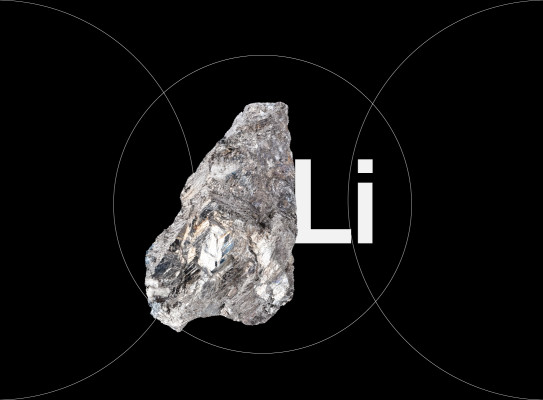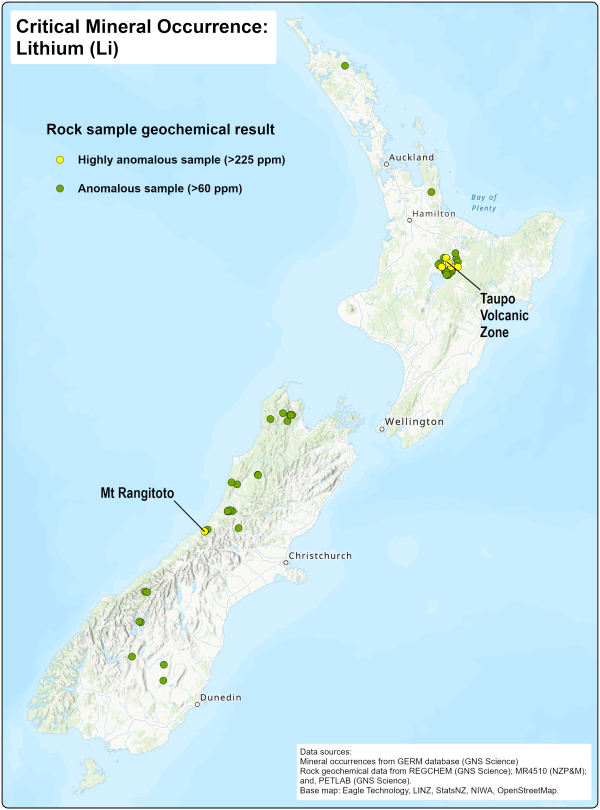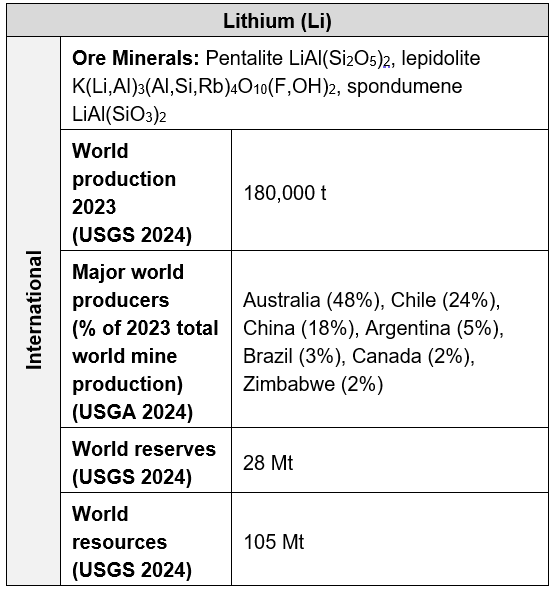Lithium

Lithium (Li) is a lightweight, highly reactive metal that plays a vital role in energy storage, high-tech industries, and advanced materials. It is best known for its use in lithium-ion batteries, which power electric vehicles (EVs), portable electronics, and renewable energy storage systems. With the global shift toward clean energy and decarbonisation, lithium has become a critical mineral for the modern economy
Lithium in New Zealand
Lithium is found in New Zealand associated with pegmatites (i.e. Lithium-Caesium-Tantalum [LCT] pegmatites) and hydrothermally altered rhyolitic, lacustrine sediment-hosted deposits (HARSH).
Pegmatites associated with strongly fractionated I-S-type felsic plutonic rocks are most likely to be associated with granitoids of the Karamea, Ridge, Rahu and Foulwind petrogenetic intrusive suites of the Tuhua Intrusives. These rocks of early Paleozoic to Cretaceous age are found in west Nelson, West Coast, Fiordland and Rakiura / Stewart Island.
The Taupō Volcanic Zone is the most prospective area for hydrothermally altered volcaniclastic/lacustrine sediments, particularly in the Huka Falls Formation (Huka Group), Ngakuru Formation and Waitemata Group sediments . Lithium is leached from rhyolitic rocks by meteoric and hydrothermal fluids, then enriched and structurally bound in volcanic-derived clays (hectorite) by hydrothermal alteration of rhyolitic lacustrine sediments. Localised areas within or proximal to the Wairakei, Tauhara, Mokai, Rotokawa, Ngatamariki, Ohaaki, Waiotapu and Rotorua geothermal fields have the highest potential for lithium mineralisation.
Felsic volcanic rocks in the Coromandel Peninsula and on Great Barrier Island may also be prospective for lithium.

Key uses of Lithium
Battery Technology – Lithium-ion batteries are essential for EVs, grid-scale energy storage, smartphones, and laptops due to their high energy density, rechargeability, and long lifespan.
Glass & Ceramics - Lithium compounds enhance heat resistance and durability in specialty glass and ceramics used in cookware, screens, and industrial applications.
Lubricants & Greases - Lithium-based greases provide high-temperature stability, essential for automotive, aerospace, and industrial machinery.
Pharmaceuticals & Medicine - Lithium carbonate is widely used in the treatment of bipolar disorder and mood disorders.
Nuclear & Metallurgical Applications - Lithium is used in nuclear fusion research, aluminum production, and high-performance alloys.
Geological Occurrence
Lithium is primarily extracted from the first two geological sources:
- Pegmatite-hosted lithium deposits – Hard-rock deposits containing lithium-bearing minerals like spodumene, lepidolite, and petalite (e.g., Greenbushes, Australia).
- Lithium brine deposits – Salt-rich groundwater in arid regions concentrates lithium in evaporative basins (salars), forming high-grade lithium brines (e.g., Salar de Atacama, Chile; Clayton Valley, USA).
- Clay-hosted lithium deposits – Found in sedimentary basins, representing an emerging resource type (e.g., Thacker Pass, USA).
- Geothermal brines & Seawater – Lithium is also present in hot spring brines and seawater, with ongoing research into economical extraction methods.

Global Supply & Strategic Importance
Australia is the largest producer of lithium, primarily from spodumene-bearing pegmatites, while Chile, Argentina, and Bolivia (the “Lithium Triangle”) hold vast lithium brine reserves. China dominates lithium refining and battery production, creating supply chain concerns and driving exploration in new regions, including Canada, the USA, and Europe.
Exploration & Future Prospects
With surging demand for EVs, renewable energy storage, and sustainable technologies, lithium exploration is expanding worldwide. Advances in geophysical surveys, geochemical techniques, and direct lithium extraction (DLE) technology are improving efficiency and sustainability.
Lithium’s role in the clean energy revolution makes it one of the most critical elements of the 21st century. As global demand increases, further investment in exploration, extraction, and recycling will be essential to secure a stable and sustainable lithium supply.
Additional reading
Turnbull RE, Hill MP, Morgenstern R, Rosenberg MD. 2019. Lithium mineral potential in the Taupo Volcanic Zone. Institute of Geological and Nuclear Sciences. 70 p. GNS Science consultancy report 2019/61. Also available as MR5633 from NZP&M
Turnbull RE, Morgenstern R, Hill MP, Durance PMJ, Rattenbury MS. 2018. Lithium mineral potential in New Zealand. Lower Hutt (NZ): GNS Science. 210 p. Consultancy Report 2018/63. Prepared for New Zealand Petroleum & Minerals.
van de Ven M, Gazley M, Sterk R, Aldrich S, Werner E. 2020. Exploration for Lithium-Caesium-Tantalum (LCT) pegmatites in New Zealand. In: Mining’s role in a prosperous low-emissions economy: New Zealand minerals forum 2020 in partnership with AusIMM conference proceedings; 2020 Oct 13–14; Hamilton, New Zealand. New Zealand Minerals Forum. p 87–91.